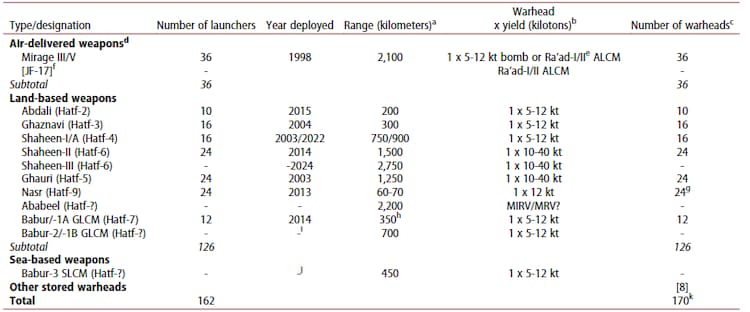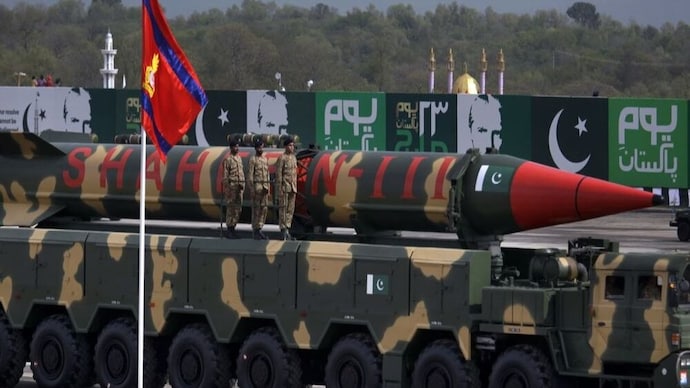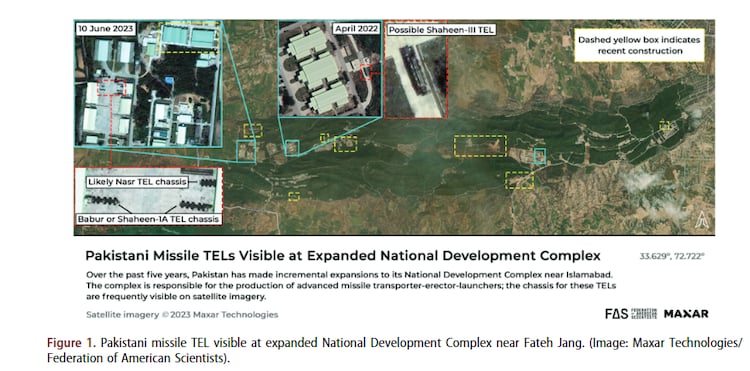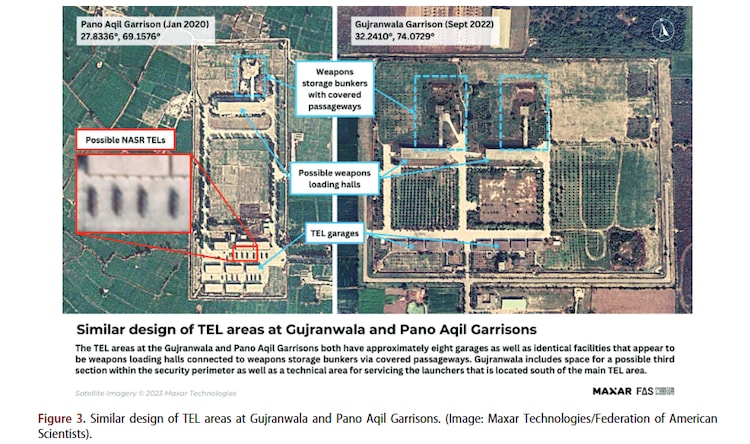
Explained via maps and satellite images: Where does Pakistan keep all its nukes?
Basis a specialised report by researchers of the Federation of American Scientists, India Today’s OSINT team charts the ever-increasing nuclear arsenal of Pakistan.

Zulfikar Ali Bhutto, former Prime Minister of Pakistan, made a resolute declaration in 1965, ''If India builds the bomb, we will eat grass or leaves – even go hungry – but we will get one of our own.'' But it took more than three decades, and a surreptitious network of theft and espionage for Pakistan, one of the world’s poorest countries to finally explode that bomb.
In the contemporary global political system, Pakistan is a de facto nuclear state, having created its nuclear program outside of the Nuclear Non-Proliferation Treaty (NPT) framework following a philosophy of ‘beg, borrow, or steal’, as per geopolitical experts.
Without China's help, Pakistan's bomb would not exist, said Gary Milhollin, a leading expert on the spread of nuclear weapons.
A specialised report published in Bulletin of the Atomic Scientists on September 11, titled the ‘2023 Pakistan Nuclear Handbook’ reckons that Pakistan possesses a stockpile of approximately 170 nuclear warheads - a gradual increase from 2022.
In the absence of publicly made statements by the nation on the strength of its nuclear arsenal, researchers Eliana Jones and Matt Korda from the Nuclear Information Project at the Federation of American Scientists analyse commercially available satellite imagery to document the expansion at army garrisons and air force bases with “more warheads, more delivery systems, and a growing fissile material production industry.”
To grasp the outline of the nation’s nuclear calculus, the India Today OSINT team spoke to Matt Korda, author of the handbook and a senior researcher for the Nuclear Information Project.
He emphasized India's perspective by mentioning, “We estimate that the nuclear stockpiles of India and Pakistan are of similar sizes, but they are postured quite differently. Pakistan's nuclear posture appears to place a premium on tactical nuclear weapons that could be used at the outset of a conflict, whereas India is working towards a more "traditional" nuclear triad that can be postured against both Pakistan and China.”
He goes on to add that “it remains unclear how high both countries' respective stockpiles will grow in the future; however, it is clear that nuclear risks in South Asia are growing. Not only are both countries increasing their nuclear readiness, but they are developing systems that place an emphasis on launching rapidly in a crisis. Given India's recent BrahMos accident last spring, and Pakistan's potential challenges with tracking the missile correctly, this all suggests that strategic stability between India and Pakistan is becoming increasingly fragile.”
Shortly after Pakistan celebrated the 25th anniversary of its inaugural nuclear tests, its ambiguous doctrine of “full spectrum deterrence”- strategic, operational and tactical with its nuclear triad based on land, air, and sea-based capabilities which gives full range coverage of the vast expanse of the Indian land mass was elucidated by Lt. Gen. (Ret.) Khalid Kidwai’s speech.
Fissile Material Production
As indicated in the report, the fissile material production facilities at Kahuta and Gadwal are nearing completion and are seemingly uranium enrichment plants. The report also identifies four heavy-water plutonium production reactors (which make plutonium for Pakistani nuclear weapons) newly constructed at the Khushab complex, nearly 33 kilometres south of Khushab in Pakistan’s Punjab province. Expansion has also been noticed in the satellite images of New Labs Reprocessing plants at Nilore, east of Islamabad and Chashma complex which reprocesses spent fuel and extracts plutonium.
Pakistan and China signed a $4.8 billion MoU to build a 1,200-megawatt nuclear power plant after hailing the investment by a country that Pakistan views as its most dependable ally, as per a report in June by Reuters.
In the Kala Chitta Dahr mountain range west of Islamabad, Pakistan expands the development of nuclear-capable missiles and their mobile launchers along its western (where they make missiles and test them), and eastern( one in the north of Fateh Jung, where they assemble the launchers that move and fire the missiles) parts. For this purpose, road-mobile transporter erector launchers (TELs) which are used to move and fire missiles are deployed in the eastern section.
Satellite images show the presence of TEL chassis for a variety of ballistic and cruise missiles. In June this year, the TEL framework was visible for Nasr, Shaheen-IA ballistic missiles, and Babur cruise missiles.
The Fateh Jang part has been expanding significantly, with new buildings for putting together launchers in the last 10 years, and it's still getting bigger. Other launcher and production facilities may have been developed near Tarnawa and Taxila region, the report mentions.
There is limited public information regarding warhead production, but experts have long speculated that the Pakistan Ordnance Factories, situated near Wah to the northwest of Islamabad, may play a significant role in this regard. Among these factories, one is located near a “unique facility with six earth-covered bunkers (igloos) inside a multi-layered safety perimeter with armed guard”.
Nuclear-capable Aircrafts and weapons
The aircraft which are most potable to have a nuclear deployment role are Pakistan’s Mirage III and Mirage V fighter squadrons. The Pakistani Air Force’s (PAF) Mirage fighter bombers are located at two bases - Masroor Air Base and Rafiqui Air Base.
Masroor Air Base outside Karachi houses the 32nd Wing with three Mirage squadrons: 7th Squadron (“Bandits”), 8th Squadron (“Haiders”), and 22nd Squadron (“Ghazis”). A possible nuclear weapons inventory is also said to be located five kilometres northwest of the base with highly guarded underground facilities potentially designed to support a nuclear strike mission. This includes a possible alert hangar with underground weapons-handling capability.
The other Mirage base is Rafiqui Air Base near Shorkot, which is home to the 34th Wing with two Mirage squadrons: the 15th Squadron (“Cobras”) and the 27th Squadron (“Zarras”).
Pakistan reportedly inducted the first batch of 12 JF-17 Block III aircraft into the 16th (“Black Panthers”) squadron in March 2023.
Pakistan's contractual agreement with the United States prohibits the modification of PAF's legacy F-16 aircraft to carry nuclear weapons. However, numerous reports indicate that Pakistan may have contemplated such modifications. The F-16A/B aircraft are stationed at Mushaf (formerly Sargodha) Air Base, which is situated approximately 160 kilometres northwest of Lahore in northeastern Pakistan and falls under the jurisdiction of the 38th Wing.
The nuclear gravity bombs for use in the event of conflict are not stored directly at the base. Instead, the report mentions that they are likely to be housed at the Sargodha Weapons Storage Complex, situated approximately 10 kilometres to the south of the base.
The newer F-16C/D aircraft are stationed at Shahbaz Air Base, located outside Jacobabad in northern Pakistan, and fall under the purview of the 39th Wing. Some F-16s are also visible at Minhas (Kamra) Air Base northwest of Islamabad, although these might be related to the aircraft industry at the base.
Land-based ballistic missiles
Pakistan currently maintains six operational nuclear-capable ballistic missile systems, which are solid-fuel and road-mobile in nature. These include the short-range Abdali (Hatf-2), Ghaznavi (Hatf-3), Shaheen-I/A (Hatf-4), and Nasr (Hatf-9), as well as the medium-range Ghauri (Hatf-5) and Shaheen-II (Hatf-6). Additionally, Pakistan is actively developing two other nuclear-capable ballistic missile systems: the medium-range Shaheen-III and the Multiple Independently Targetable Reentry Vehicle (MIRVed) Ababeel.
The analysis of satellite imagery suggests that Pakistan maintains at least five missile bases that could serve a role in Pakistan’s nuclear forces however, distinguishing between military installations primarily designated for conventional strike operations and those with dual-capabilities or specialized for nuclear strike roles poses a significant challenge.
- Arko Garrison: Having undergone gradual expansion since 2004, the Arko Garrison located around 145 kilometres away from the Indian border, consists of sic missile TEL garages that appear to be designed for at least twelve launchers. Under the TEL garage complex, satellite imagery shows the construction of a unique underground facility.The underground facility has two cross-shaped sections connected by a central corridor that leads to two buildings on either side via covered access ramps. By analysing the vehicle training area lying in the northeast corner of the garrison, what appears to be five-axle TELs for the Babur cruise missile weapon system are placed.
- Gujranwala Garrison: The Gujranwala Garrison, one of the largest military complexes in Pakistan, is located just about 60 kilometres from the Indian border. Several trucks that strongly resemble the Nasr short-range missile system can be seen on satellite imagery. The estimated range of Nasr’s is equivalent to the garrison’s distance from the Indian border.
- Khuzdar Garrison: Located farthest from the Indian border, the southern section of Khuzdar Garrison expanded its perimeter in late 2017 to include three additional TEL garages, bringing the total to six. Also included in this section are two multi-story weapon-handling buildings with covered ramps leading to a possible underground nuclear storage area similar to the one visible at the Akro Garrison.
- Pano Aqil Garrison: The Pano Aqil Garrison is located only 85 kilometres from the Indian border, in the northern part of Sindh Province. This garrison could potentially support approximately 50 TELs; however, some of these garage spaces are likely to hold support vehicles as well. Large numbers of TELs, including for Babur and Shaheen-I missiles, are regularly visible at this garrison through commercial satellite imagery.
- Sargodha Garrison: The Sargodha Garrison, located in the Kirana Hills, was a site used by Pakistan for nuclear development from 1983 to 1990. Near a conventional munitions storage area, there are ten potential Transporter Erector Launcher (TEL) garages and two maintenance garages. The TEL area's layout differs from others in the country, possibly due to its age. East of the munitions area, an underground storage facility is built into the mountain with at least ten entrances visible through satellite imagery. There are also structures suggesting weapon and missile handling facilities.
Pakistan is also actively developing its family of ground- and sea-launched cruise missiles, including the Babur (Hatf-7). This subsonic, dual-capable cruise missile bears a visual resemblance to the US Tomahawk, Chinese DH-10, and Russian AS-15 cruise missiles. According to the Pakistani government, the Babur boasts "stealth capabilities," "pinpoint accuracy," and is characterized as a "low-altitude, terrain-hugging missile with high manoeuvrability." Notably, the Babur's slim design compared to Pakistan's ballistic missiles suggests progress in warhead miniaturization through a boosted fission design, as per the report.
Given the lack of official statements on a nation's most secretive nuclear capabilities, Matt Korda lays out the advantages of open-source data which allows little for a nation to now hide with the availability of publicly accessible satellite data. “The open-source information landscape is changing rapidly, as emerging technologies and increasingly networked systems allow for new methods of information-gathering.
We’re now at the point where significant improvements in commercial satellite technology––plus the proliferation of high-cadence, near-daily imagery––now allow independent researchers to use these tools to track military developments in nearly real-time.”
He adds, “Moreover, the barrier to entry for open-source researchers to access valuable open-source information is continuously shrinking. This is a dramatic change from merely a few decades ago, when governments maintained an exclusive monopoly on satellite imagery and could unilaterally decide whether to disclose particular images or discoveries to the public. This means that governments will increasingly face challenges when trying to hide major military and nuclear deployments from their publics, allies, and adversaries.”





